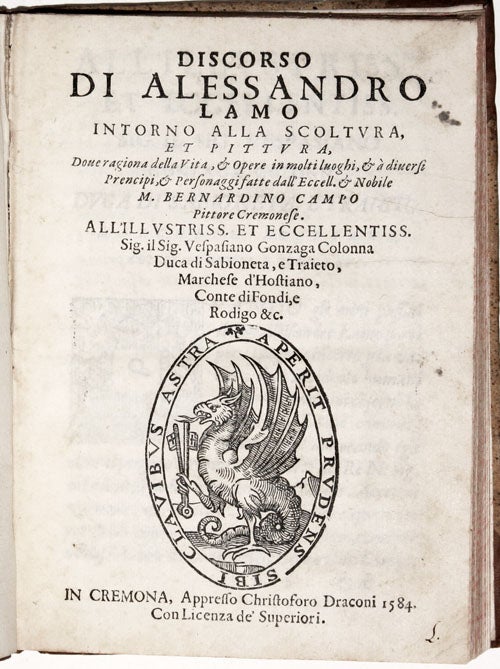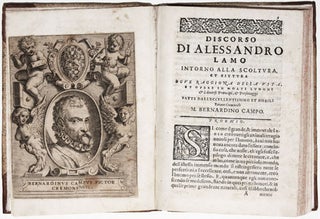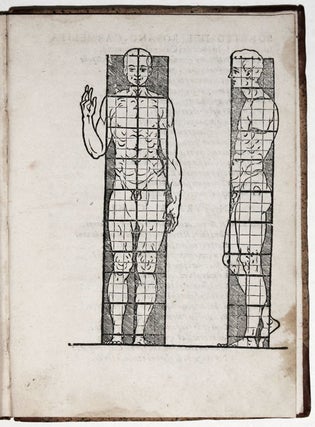Discorso di Alessandro Lamo intorno alla scoltura, et pittura, dove ragiona della vita, & opere in molti luoghi, & à diversi prencipi, & personaggi fatte dall’eccel. & nobile M. Bernardino Campo pittore Cremonese.
4to [18.9 x 13.6], (3) ff., (1) f. integral blank, 118 pp., (1) f. integral blank, (6) ff., with engraved printer’s device on title, engraved portrait laid down to first integral blank, woodcut initials, and a full-page woodcut on human proportion. Half bound in early calf with sprinkled boards, gold-stamped title label laid to spine, red sprinkled edges. Some wear to spine, joints tender. Occasional minor spotting and staining, some browning in the middle quires (F-M), engraving browned and with tear at bottom corner, contemporary annotations on verso of final leaf.
Rare first edition of Alessandro Lamo’s (1546-1610) illustrated evaluation of the life and work of the Cremonese painter Bernardino Campi (1522-1591). The Discorso, in addition to being the principal source for Campi’s biography, is considered the first critical writing to examine a still-living artist through the lens of regional art history (Schlosser, p. 365). The volume’s engraved frontispiece, a bust-length portrait of Campi surrounded by the attributes of his profession, is the work of renowned Bologna artist Agostino Carracci (1557-1602): “Not only the engraving but also the book by Lamo is very rare. In several copies of the book, the engraving is missing, and in several print rooms the engraving is found apart from the book” (DeGrazia, p. 222). The volume concludes with a short treatise, Parer sopra la pittura, written by Campi himself and which includes a full-page woodcut treating human proportion.
In defending Cremonese artists from the slights and omissions of Giorgio Vasari (“an enemy of Lombard painters,” p. 39), Lamo provides much local information not found elsewhere, including key details of the early life of Campi’s most famous student and the preeminent female artist of the Renaissance, Sofonisba Anguissola (1532-1625), whose apprenticeship from the age of 14 is recorded here (pp. 37-8) (Vasari, by contrast, had erroneously named Bernardino’s brother Giulio Campi as Sofonisba’s teacher.) Lamo prints a letter written by Sofonisba to Campi from Madrid in October of 1551 and signed “Your most affectionate student” (p. 43-4). There follow other interesting letters to Campi written both by patrons (e.g., Ippolita Gonzaga) and colleagues (e.g. the Florentine painter Francesco Salviati), as well as extensive poetic praise for Campi’s portraiture (of Vittoria Colonna, Vespasiano Gonzaga, etc.).
The Parer sopra la pittura, which appears at the end of the volume with its own title page, is often missing from copies of the Discorso. This short work, in which Campi describes his method for making wax and gesso models to help with the preliminary design of his paintings, is a key document for understanding the workshop practice of Renaissance painters (see Ragazzi’s study and edition of the Parer sopra la pittura). The full-page woodcut depicts a nude youth from the front and side and is overlaid with a grid to suggest the ideal proportions of these figures. Campi concludes that adjustments must, of course, be made for more burly subjects like Hercules and for women.
Two different issues of the book are recorded by bibliographies, with the difference regarding the fourth leaf: In one case, this leaf is an integral blank (e.g., the Getty copy), while in the other it is the full-page engraved portrait of Campi. The present copy is of the first variant, but the portrait engraving is present here and has been affixed to the blank. Traces of red ink from the sprinkled edges of this volume are to be seen on the edges of both the blank and the engraving, suggesting that the engraving was included at an early period of the book’s history; that the Harvard copy of the Discorso also contains a “supplied” example of the engraving might suggest that this pasted-in engraving represents a third issue.
The text of the Discorso was reprinted in 1774 in the first volume of Giambattista Zaist’s Notizie istoriche de’ pittori, scultori, ed architetti cremonese.
OCLC locates U.S. copies at Yale, Harvard, Princeton, Getty, National Gallery, Metropolitan Museum, and the Folger Library (imperfect, lacking woodcut).
* Cicognara, p. 154; Alexandre Ragazzi, “Un episodio nella storia modelli plastici ausiliari – il Parere sopra la pittura di Bernardino Campi,” RHAA 8, pp. 39-49, 123-31; Diane DeGrazia, Prints and Related Drawings by the Carracci Family: A Catalogue Raisonné; Julius von Schlosser, Letteratura artistica; Zappella, Il ritratto italiano nel libro del Cinquecento, n. 81 and pp. 78, 128, and 147.
Price: $9,500.00



